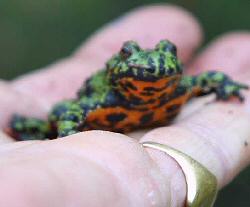
Fire/Yellow-bellied Toads – Bombina bombina/variegata/orientalisIntroductionThese amphibians belong to a family of
quite primitive frogs & toads – the Discoglossidae
(possessing a round tongue) and they are related to both
Painted Frogs & Midwife Toads. The terms ‘frog’ and
‘toad’ being quite subjective in this family, those with
warty skins being termed toads! There are three species
that are likely to be kept in captivity: Fire-bellied
Toads & Yellow-bellied Toads from Europe, and Oriental
Fire-bellied Toads from Korea/Russia. All are attractive
and easy to keep – and with a bit of effort easy to
breed as well. Bear in mind that these toads are
long-lived (10 years or more) and sociable so it is
worth investing in a mixed sex group of one species.
AccommodationOriental Fire-bellied Toads are highly sociable and should not be kept alone. They are semi-aquatic and will spend time both in and out of the water so need an aqua-terrarium, that is an aquarium with at least 1/3 given to land and water no deeper than 10cm. Alternatively a terrarium with a water section at the front will suffice. A terrarium 1m x 0.5 x 0.5 would accommodate 6 animals.They appreciate live vegetation – both in the water (Canadian Pondweed, Indian Fern, etc), and on land (Scindapsus, Java Fern, Bromeliads, Orchids, etc). Good lighting is essential but even with UV tubes the belly colour is apt to fade. For best colouration they should be kept in an outdoor reptilliary or greenhouse. They are very tolerant of temperature but ideally 19-24o C with a cooler winter period. If kept outdoors they should successfully hibernate, but not for newly imported Korean animals. Although they appear a little ungainly they can in fact climb quite well and will escape from any vivarium that is not securely covered. BreedingThey will breed fairly readily
in captivity – particularly in outdoor/greenhouse
conditions. Moreover, they breed repeatedly from early
spring through summer. Adults are quite easy to sex,
though at first glance the two sexes appear similar. If
you have a pair the male will have sturdier forelegs,
more extensive webbing between the hind toes, slightly
spiny skin and a voice! The call is a high soft honk
which can carry a surprising distance to attract a mate.
Females do emit a rapid call when annoyed – usually by
an over-amorous male! FeedingToads can only detect moving prey, hence live food is essential. They will take most commercially available livefoods as well as smaller earthworms, smooth caterpillars, and insect sweepings. It is vital to dust commercial livefoods with a multi-vitamin powder regularly. Do not feed adults every day as they will become obese and lose vitality.Juveniles are quite easy to rear on smaller insects and DO need feeding every day – they should grow rapidly. N.B. Adults will occasionally cannibalise juveniles so rear them separately. Obtaining your animalsThe European species are protected but are available from breeders now and again. The Oriental Fire-bellied Toad is frequently imported, but again it is preferable to support the captive breeding of the species by obtaining from reputable hobbyists. |
||||||||
